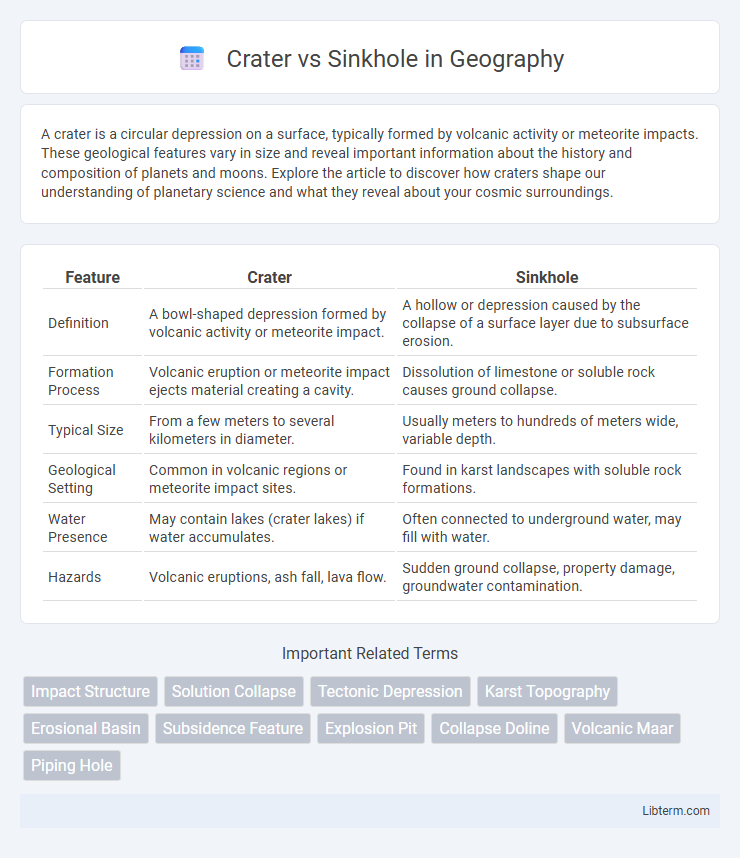A crater is a circular depression on a surface, typically formed by volcanic activity or meteorite impacts. These geological features vary in size and reveal important information about the history and composition of planets and moons. Explore the article to discover how craters shape our understanding of planetary science and what they reveal about your cosmic surroundings.
Table of Comparison
| Feature | Crater | Sinkhole |
|---|---|---|
| Definition | A bowl-shaped depression formed by volcanic activity or meteorite impact. | A hollow or depression caused by the collapse of a surface layer due to subsurface erosion. |
| Formation Process | Volcanic eruption or meteorite impact ejects material creating a cavity. | Dissolution of limestone or soluble rock causes ground collapse. |
| Typical Size | From a few meters to several kilometers in diameter. | Usually meters to hundreds of meters wide, variable depth. |
| Geological Setting | Common in volcanic regions or meteorite impact sites. | Found in karst landscapes with soluble rock formations. |
| Water Presence | May contain lakes (crater lakes) if water accumulates. | Often connected to underground water, may fill with water. |
| Hazards | Volcanic eruptions, ash fall, lava flow. | Sudden ground collapse, property damage, groundwater contamination. |
Understanding Craters and Sinkholes
Craters are typically formed by volcanic activity or meteorite impacts, characterized by a circular depression with raised rims, whereas sinkholes result from the collapse of the ground due to the dissolution of underlying limestone or other soluble rock. The size and shape of craters vary based on the impact energy or volcanic eruption intensity, while sinkholes often occur suddenly and can cause significant damage to infrastructure. Understanding the geological processes behind both features aids in hazard assessment and land use planning in vulnerable regions.
Key Differences Between Craters and Sinkholes
Craters are typically circular depressions formed by volcanic activity, meteorite impacts, or explosions, characterized by raised rims and steep walls. Sinkholes result from the collapse of underground cavities, often in limestone or soluble rock regions, causing sudden ground subsidence without raised edges. Unlike craters, sinkholes vary widely in size and shape and are primarily influenced by geological processes like erosion and groundwater drainage.
Geological Processes Behind Craters
Craters form primarily through volcanic activity or impact events, where intense energy releases result in circular depressions on Earth's surface. Volcanic craters develop as magma erupts or collapses within a volcano's summit, whereas impact craters form from meteorite collisions that create shock waves fracturing bedrock. These geological processes differ significantly from sinkholes, which result from subterranean erosion and the dissolution of soluble rocks like limestone.
Formation Mechanisms of Sinkholes
Sinkholes form primarily through the dissolution of soluble bedrock such as limestone, gypsum, or salt by groundwater, leading to subterranean voids that collapse under surface weight. This karst process contrasts with craters, which typically result from volcanic eruptions or meteorite impacts. Understanding the chemical weathering and groundwater fluctuations is crucial for predicting sinkhole occurrences in susceptible regions.
Types of Craters: Impact, Volcanic, and More
Impact craters form when meteoroids or asteroids collide with a planetary surface, creating a circular depression characterized by a raised rim and sometimes central peaks. Volcanic craters result from explosive volcanic activity, typically forming at the summit of a volcano or within a caldera, where magma has erupted or collapsed. Other types include explosion craters created by underground blasts and erosion craters shaped by weathering processes, each differing in origin and morphology from sinkholes caused by subsurface dissolution of soluble rock.
Classification of Sinkholes: Solution, Collapse, and Dropout
Sinkholes are classified into three primary types based on their formation mechanisms: solution, collapse, and dropout sinkholes. Solution sinkholes form gradually as acidic water dissolves soluble bedrock such as limestone, creating depressions. Collapse sinkholes occur suddenly when an underground cavity's roof collapses, whereas dropout sinkholes happen when loose sediments wash away, causing the surface material to drop into voids below.
Environmental Impact: Craters vs Sinkholes
Craters, formed by volcanic activity or meteorite impacts, often result in significant disruption to ecosystems, soil composition, and air quality due to ash and gas emissions. Sinkholes, caused by the dissolution of soluble bedrock, primarily affect groundwater flow and can lead to the sudden collapse of land, threatening nearby habitats and infrastructure. Both geological formations alter local environments, but sinkholes tend to have a more immediate impact on water systems and land stability.
Famous Craters and Sinkholes Around the World
Famous craters such as the Meteor Crater in Arizona and the Ngorongoro Crater in Tanzania showcase impact and volcanic origins, with distinct circular depressions formed by meteor impacts or volcanic activity. Renowned sinkholes like the Great Blue Hole in Belize and the Xiaozhai Tiankeng in China highlight natural collapses of the earth's surface caused by erosion and underground water drainage. These geological features attract scientists and tourists alike, exemplifying diverse natural processes shaping our planet.
Human Interaction and Risk Management
Crater formation often results from volcanic activity or explosive events, posing risks primarily in geological hazard zones, while sinkholes commonly emerge due to groundwater erosion and urban infrastructure weaknesses, creating immediate threats to buildings and transportation networks. Human interaction with craters involves monitoring volcanic activity and implementing evacuation plans, whereas sinkhole risk management emphasizes land-use planning, soil stabilization, and early detection technologies. Effective risk mitigation requires tailored strategies that address the distinct causes and impacts of craters and sinkholes on communities and critical infrastructure.
Summary: Crater vs Sinkhole at a Glance
Crater and sinkhole are distinct geological features with unique formation processes and appearances. Craters typically form from volcanic activity or meteorite impacts, characterized by a circular depression with raised rims, while sinkholes result from the collapse of soluble rock beneath the surface, creating irregular, sudden depressions. Understanding these differences is crucial for geological studies, hazard assessment, and land-use planning.
Crater Infographic

 libterm.com
libterm.com